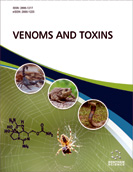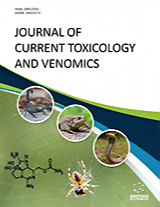Abstract
Background: The diversity of components in arthropod venoms constitute a rich source of bioactive molecules. Brazil is the most biodiverse country in the world, comprising 15 to 20% of the total catalogued species, with approximately 103,870 animal species including arthropods. Although many articles mention the biotechnological potential of these venoms and toxins, only a few studies compile the patented uses of these molecules.
Objective: This review describes the knowledge about the molecular mechanism of venoms and toxins with biotechnological potential, and lists the patents deposited up to 2021 related to the main medical relevant arthropods in Brazil including the orders Araneae (spider genus Phoneutria, Loxosceles, Latrodectus), Scorpiones (scorpion genus Tityus), Lepidoptera (caterpillar genus Lonomia), and Hymenoptera.
Methods: The international patent search engine “Espacenet” and the “Brazilian patent office” were used to search the patents described in this article.
Results: Up to date, 34 patents have been filled involving these Brazilian arthropods' venoms or toxins. Most of them (20) claimed biotechnological inventions with spider toxins, mainly from the genus Phoneutria. Only seven inventions involved venom or toxins from scorpions, one from a bee, three from wasps, and three from caterpillars.
Conclusions: Brazil is one of the main references in venoms and toxins’ studies; however, the limited number of deposited patents related to this area by Brazilian researchers do not reflect their pioneer position in this field. On the other hand, patents were well described and made with purified toxins, rather than with the whole venom. Nevertheless, the vast publication record of venom and toxin characterization that leads to a better understanding of their molecular mechanisms paves the way for turning these promising molecules into possible products.
Keywords: Patent, Venom, Brazil, Arthropod, Toxin, Biotechnological Potential
Graphical Abstract
[http://dx.doi.org/10.1002/ps.5452] [PMID: 31025461]
[http://dx.doi.org/10.26633/RPSP.2021.55]
[http://dx.doi.org/10.1016/0041-0101(91)90195-W] [PMID: 1801316]
[http://dx.doi.org/10.1016/0041-0101(94)00130-Z] [PMID: 7778132]
[http://dx.doi.org/10.1007/978-94-007-6389-0_6]
[http://dx.doi.org/10.1124/mol.105.021147] [PMID: 16505156]
[http://dx.doi.org/10.1016/j.biochi.2012.08.016] [PMID: 22968173]
[http://dx.doi.org/10.1016/j.toxicon.2018.07.008] [PMID: 30003916]
[http://dx.doi.org/10.1016/0014-5793(92)81318-G] [PMID: 1397265]
[http://dx.doi.org/10.3390/toxins10090337] [PMID: 30134593]
[http://dx.doi.org/10.1021/bi802158p] [PMID: 19231838]
[http://dx.doi.org/10.1016/j.toxicon.2008.02.010] [PMID: 18397797]
[http://dx.doi.org/10.1038/ijir.2011.47] [PMID: 21975567]
[http://dx.doi.org/10.1016/j.juro.2015.06.081] [PMID: 26119670]
[http://dx.doi.org/10.1111/bph.13448] [PMID: 26947933]
[http://dx.doi.org/10.1186/s40409-016-0091-6] [PMID: 28031732]
[http://dx.doi.org/10.3390/toxins10010043] [PMID: 29342943]
[http://dx.doi.org/10.1167/tvst.9.8.33] [PMID: 32855879]
[http://dx.doi.org/10.1007/978-94-007-6389-0_6]
[http://dx.doi.org/10.1046/j.1471-4159.1999.721472.x] [PMID: 10098851]
[PMID: 29107209]
[http://dx.doi.org/10.1016/j.toxicon.2010.11.013] [PMID: 21115025]
[http://dx.doi.org/10.1016/S0028-3908(99)00267-1] [PMID: 10884557]
[http://dx.doi.org/10.1097/PR9.0000000000000610] [PMID: 29392225]
[http://dx.doi.org/10.1074/jbc.M112348200] [PMID: 11827974]
[http://dx.doi.org/10.1097/IAE.0b013e318205b249] [PMID: 21394062]
[http://dx.doi.org/10.3390/toxins8030070] [PMID: 26978403]
[http://dx.doi.org/10.1002/hipo.20580] [PMID: 19370546]
[http://dx.doi.org/10.1111/j.1526-4610.2011.02053.x] [PMID: 22289052]
[http://dx.doi.org/10.1016/j.brainres.2008.10.038] [PMID: 18996361]
[http://dx.doi.org/10.1007/s00424-016-1801-1] [PMID: 26898377]
[http://dx.doi.org/10.1016/j.pain.2008.07.014] [PMID: 18774645]
[http://dx.doi.org/10.1124/jpet.105.087023] [PMID: 15933156]
[http://dx.doi.org/10.1016/j.lfs.2017.06.018] [PMID: 28629730]
[http://dx.doi.org/10.1016/j.jpain.2014.02.007] [PMID: 24607814]
[http://dx.doi.org/10.1111/bph.13652] [PMID: 27759880]
[http://dx.doi.org/10.1007/s12035-018-1049-1] [PMID: 29667130]
[http://dx.doi.org/10.1002/jcp.26935] [PMID: 30078202]
[http://dx.doi.org/10.1038/s41598-020-62620-9] [PMID: 32246025]
[http://dx.doi.org/10.1016/j.toxicon.2017.02.001] [PMID: 28202361]
[http://dx.doi.org/10.1016/S0041-0101(00)00129-X] [PMID: 10978749]
[http://dx.doi.org/10.1016/j.toxicon.2016.01.056] [PMID: 26802625]
[http://dx.doi.org/10.1590/1678-9199-jvatitd-2019-0022] [PMID: 31467512]
[http://dx.doi.org/10.1016/j.biochi.2015.12.019] [PMID: 26747232]
[http://dx.doi.org/10.3390/toxins8040106] [PMID: 27077886]
[http://dx.doi.org/10.1016/j.toxcx.2020.100045] [PMID: 32875290]
[http://dx.doi.org/10.1016/S0022-1910(01)00143-3] [PMID: 12770132]
[http://dx.doi.org/10.1371/journal.pone.0200628] [PMID: 30067761]
[http://dx.doi.org/10.1016/j.toxicon.2019.03.014] [PMID: 30902682]
[http://dx.doi.org/10.1016/S0145-305X(03)00058-2] [PMID: 12818635]
[http://dx.doi.org/10.1007/s00018-010-0364-0] [PMID: 20369272]
[http://dx.doi.org/10.3390/toxins12030164] [PMID: 32155765]
[http://dx.doi.org/10.3390/toxins12040256] [PMID: 32316084]
[http://dx.doi.org/10.3390/toxins3030309] [PMID: 22069711]
[http://dx.doi.org/10.1016/j.biotechadv.2007.12.003] [PMID: 18207690]
[http://dx.doi.org/10.3390/toxins11060355] [PMID: 31248109]
[http://dx.doi.org/10.1093/ajcp/100.5.576] [PMID: 8249897]
[http://dx.doi.org/10.1016/j.toxicon.2004.05.028] [PMID: 15302533]
[http://dx.doi.org/10.1111/imb.12268] [PMID: 27743460]
[http://dx.doi.org/10.3390/toxins10120522] [PMID: 30563217]
[http://dx.doi.org/10.1016/j.toxicon.2019.06.225] [PMID: 31251993]
[http://dx.doi.org/10.1016/j.toxlet.2018.09.008] [PMID: 30261224]
[http://dx.doi.org/10.1002/jbt.20244] [PMID: 18972397]
[http://dx.doi.org/10.1016/j.ajem.2008.10.033] [PMID: 19751653]
[PMID: 28469986]
[http://dx.doi.org/10.1016/j.toxcx.2020.100062] [PMID: 33163957]
[http://dx.doi.org/10.3390/toxins7124862] [PMID: 26633495]
[PMID: 2285428]
[http://dx.doi.org/10.1085/jgp.88.1.59] [PMID: 3488369]
[http://dx.doi.org/10.1016/0005-2736(94)00226-F] [PMID: 7530491]
[http://dx.doi.org/10.1016/0014-5793(93)80803-3] [PMID: 8262230]
[http://dx.doi.org/10.3390/toxins11060370] [PMID: 31242582]
[http://dx.doi.org/10.1016/j.fertnstert.2006.11.054] [PMID: 17207796]
[http://dx.doi.org/10.3109/19396360903497217] [PMID: 20170285]
[http://dx.doi.org/10.1071/RD11180] [PMID: 22781938]
[http://dx.doi.org/10.1111/j.1439-0272.2011.01263.x] [PMID: 22211875]
[http://dx.doi.org/10.3390/toxins3050489] [PMID: 22069721]
[http://dx.doi.org/10.3390/toxins7124887] [PMID: 26670253]
[http://dx.doi.org/10.1016/S0300-9084(00)01171-8] [PMID: 11086221]
[http://dx.doi.org/10.1002/ps.5206] [PMID: 30204933]
[http://dx.doi.org/10.3390/toxins7030886] [PMID: 25785465]
[http://dx.doi.org/10.1002/jbt.21553] [PMID: 24616210]
[http://dx.doi.org/10.1098/rsif.2018.0581] [PMID: 30958158]
[http://dx.doi.org/10.3390/toxins10110451] [PMID: 30400202]
[http://dx.doi.org/10.3892/etm.2017.4391] [PMID: 28587399]
[http://dx.doi.org/10.3390/biomedicines8050118] [PMID: 32408604]
[http://dx.doi.org/10.2174/092986609788923329] [PMID: 19689419]
[http://dx.doi.org/10.4236/ojgen.2012.24027]
[http://dx.doi.org/10.1074/jbc.M006810200] [PMID: 10970898]
[http://dx.doi.org/10.1371/journal.pntd.0007048] [PMID: 31002673]
[http://dx.doi.org/10.1016/j.toxicon.2014.07.014] [PMID: 25091350]
[http://dx.doi.org/10.1038/s41598-018-33133-3] [PMID: 30282983]
[http://dx.doi.org/10.1016/j.ejphar.2019.05.002] [PMID: 31059709]
[http://dx.doi.org/10.1016/j.peptides.2015.03.003] [PMID: 25805002]
[http://dx.doi.org/10.3390/toxins10040161] [PMID: 29670004]
[http://dx.doi.org/10.3390/toxins11090517] [PMID: 31489876]
[http://dx.doi.org/10.3390/toxins10060219] [PMID: 29848960]
[http://dx.doi.org/10.3389/fmicb.2016.01844] [PMID: 27917162]
[http://dx.doi.org/10.1186/s40409-015-0042-7] [PMID: 26500679]
[http://dx.doi.org/10.1016/j.toxicon.2019.06.019] [PMID: 31207348]
[http://dx.doi.org/10.1136/bmjopen-2013-004602] [PMID: 24760349]
[http://dx.doi.org/10.3390/toxins7041126] [PMID: 25835385]
[http://dx.doi.org/10.1016/0041-0101(72)90119-5] [PMID: 4198739]
[http://dx.doi.org/10.1016/0041-0101(72)90061-X] [PMID: 5070576]
[PMID: 2242083]
[http://dx.doi.org/10.1007/BF02976695] [PMID: 12785734]
[http://dx.doi.org/10.1016/j.jep.2005.02.026] [PMID: 15848037]
[http://dx.doi.org/10.3390/toxins11070374] [PMID: 31252651]
[http://dx.doi.org/10.3390/molecules25030556] [PMID: 32012913]
[http://dx.doi.org/10.1016/j.toxicon.2008.06.007] [PMID: 18602939]
[http://dx.doi.org/10.2147/CIA.S84940] [PMID: 26491274]
[http://dx.doi.org/10.1016/0009-2797(92)90106-U] [PMID: 1314707]
[http://dx.doi.org/10.3390/biom10020247] [PMID: 32041197]
[http://dx.doi.org/10.1016/j.canlet.2017.05.010] [PMID: 28536009]
[http://dx.doi.org/10.3892/mmr.2017.6970] [PMID: 28713976]
[http://dx.doi.org/10.3390/molecules24091775] [PMID: 31067828]
[http://dx.doi.org/10.1039/C6CS00076B] [PMID: 27188322]
[http://dx.doi.org/10.1007/s00429-016-1258-1] [PMID: 27357310]
[http://dx.doi.org/10.1021/acs.biochem.9b01098] [PMID: 31990535]
[http://dx.doi.org/10.1016/j.toxicon.2019.03.008] [PMID: 30880185]
[http://dx.doi.org/10.1016/j.toxicon.2020.11.176] [PMID: 33290790]
[http://dx.doi.org/10.1016/j.toxicon.2021.04.028]
[http://dx.doi.org/10.1074/jbc.270.9.4923] [PMID: 7876267]
[http://dx.doi.org/10.1016/j.toxicon.2018.04.029] [PMID: 29715467]
[http://dx.doi.org/10.1016/j.ijantimicag.2016.11.013] [PMID: 28108242]
[http://dx.doi.org/10.3390/toxins12090550] [PMID: 32867207]
[http://dx.doi.org/10.1016/j.toxicon.2016.09.015] [PMID: 27664832]
[http://dx.doi.org/10.4103/0973-1296.103657] [PMID: 24082633]
[http://dx.doi.org/10.1016/j.npep.2020.102113] [PMID: 33370615]
[http://dx.doi.org/10.1111/j.1742-7843.2005.pto_137.x] [PMID: 16236140]
[http://dx.doi.org/10.1016/j.cca.2005.05.004] [PMID: 15953769]
[http://dx.doi.org/10.1016/j.toxicon.2021.02.009] [PMID: 33610635]
[http://dx.doi.org/10.1038/sj.bjp.0707275] [PMID: 17533426]
[http://dx.doi.org/10.3390/biomedicines8060143] [PMID: 32486237]
[http://dx.doi.org/10.1016/S0049-3848(01)00268-7] [PMID: 11395129]
 1
1




